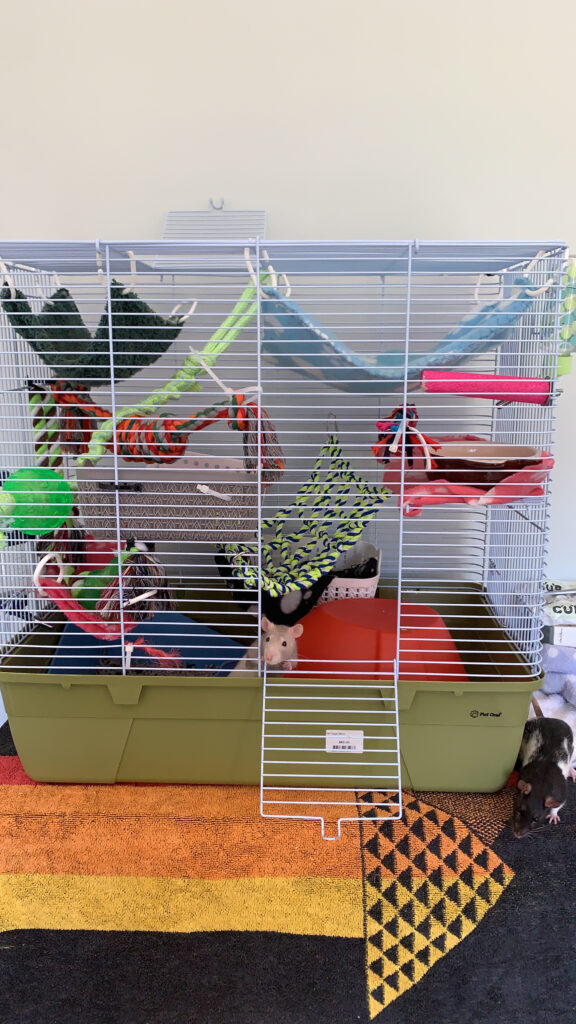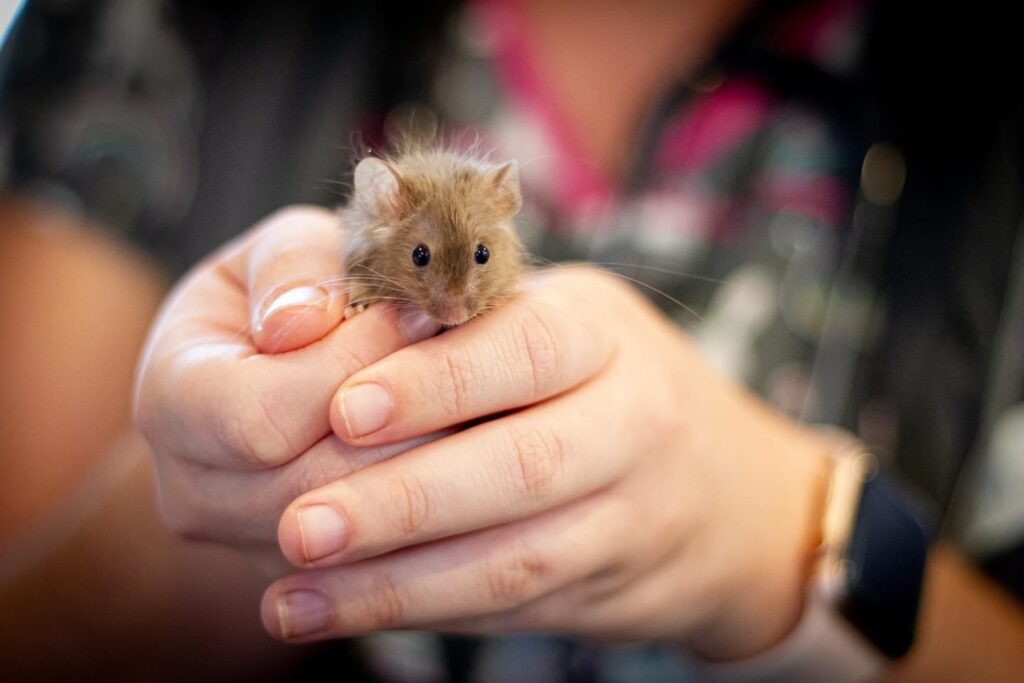Mice can be wonderful companions for both adults and children. They are intelligent, playful, and entertaining to watch. Some can be a little skittish but can warm up to handling if tamed from a young age. They are largely nocturnal.
The commonly kept pet mice have been domesticated from the wild house mice Mus musculus. Through breeding by mouse fanciers, this has resulted in a variety of coat colours and patterns.
In the wild, mice are gregarious and stay in family groups called demes, which consist of dominant breeding male, a hierarchy of females, sub ordinate males and juveniles. For this reason, females are usually fine when housed together but intact males should not be housed together unless they are litter mates or have been introduced to each other from a young age. Unfamiliar intact male mice can be aggressive to each other, resulting in injuries and potentially death.
- The average lifespan of a mouse is about 12 to 36months
- The average weight of an adult mouse is approximately 20-40g for males and 18-35g for females
- Mice reach sexual maturity around 4-6 weeks of age
- Females tend to be less odourous than males
Husbandry and housing
As noted above, mice are social, gregarious creatures and would benefit from being housed with other mice. Females or mixed sex pairs generally do well together, just remember, they are prolific breeders so unless babies are wanted, it is advised to castrate the males.

The goal for choosing a cage is to ensure it is easy to clean and is escape proof. The material used should be impervious to chewing i.e. no wood or cardboard. Stainless steel, durable plastic or wire would be suitable, however, wire floors can lead to foot issues, and so wires should be covered with newspapers or towels.
Ventilation is important to reduce ammonia build up and exposure (produced by their excrement) as this can damage the eyes and airways of mice. A solid plastic base with closely spaced metal bars (so they cannot escape) are ideal for ventilation. Aquarium tanks should be avoided. See cleaning*
The larger the cage, the better, keeping in mind the minimal cage size for a SINGLE mouse should be 46cm x 30x cm x 30cm (Cage size calculators may be found online). Having multiple levels can be beneficial to encourage normal behavior, sufficient exercise, and provide enrichment. Provide hiding places such as cardboard boxes, shredded paper, and PVC pipes for a safe place to nest and rest. See enrichment*
Substrate, bedding or flooring material should be at least 3-4cm deep to allow burrowing, resting and urine soaking. Aim to use clean, absorbent, non-toxic, odour-free bedding such as recycled paper cat litter or shredded paper.
Avoid cedar (contains toxic chemicals), corn cob (tends to mold and can cause obstruction in ingested) and sawdust or pine shavings (irritate eyes and respiratory tract).
Temperature should be around 18 to 26 degrees, keeping out extreme temperature fluctuations such as with direct sunlight, near radiators, or drafts. Mice are sensitive to heat exhaustion, especially when temperatures reach 30 degrees and over, so please keep your mouse cool with plenty of hydration during the warmer seasons as heat stress can lead to death.
Cleaning
Respiratory problems are one of the more common diseases in mice. Ammonia is produced in their urine and faeces, and is an irritant to the eyes and respiratory system, compromising the normal immune function of the cell lining. Ventilation and cleanliness is important in reducing ammonia build up in the environment. Studies have shown a positive correlation with high ammonia levels and mycoplasma pulmonis lung infections. Aim to clean regularly to remove organic debris, and reduce the number of bacteria and fungi in the environment.
Feed and water dishes should be emptied and cleaned daily by scrubbing with detergent and drying. Soiled bedding and uneaten food should also be removed daily. Only feed what they will eat in a day.
A thorough clean should be carried out at least once to twice a week, cleaning the entire cage including cage furnishings. Hot soapy water with energetic cleaning using a cloth or scour pad should be adequate. Rinse the cage well with water and leave to dry before returning your pet to the cage.
Enrichment
Mental wellbeing is just as important as the physical. In the wild, mice would spend all day foraging for food, compared to a pet having food presented to them on a plate. This can result in lazy and overweight mice. Environmental enrichment should be provided to alleviate boredom and recreate activities normally undertaken in the wild.
When choosing items to use, please keep in mind how safe it is for your mice- will they swallow portions of the toy? Will they injure themselves? Can they become tangled or trapped in it?
- Chew toys: Mice love chewing. Objects tough enough to withstand munching include wooden toys, chew blocks, cardboard tube rolls, and hard low fat dog biscuits
- Climbing toys: Allows use of vertical areas of the cage, such as ladders, natural tree branches, thick rope
- Foraging toys: can make paper bon bons with treats hidden in the middle, provide a digging box (box filled with coconut mulch, shredded tissue etc), a treat piñata with treats wrapped in paper and hung on the cages
- Hidey holes: for shelter, a place to feel secure, and nest. You can use toilet paper rolls, and empty tissue boxes. Shredded tissues or paper towels can provide a soft bed
- Exercise wheels
Please avoid fluffy cotton wool products as they are indigestible and may cause an obstruction if ingested.
Desexing
Castrating male mice are may be performed at 8-12 weeks of age to decrease the incidence of inter-male aggression and fights, to prevent unwanted pregnancies, and reduce pet odours.
Health Checks
It is advised to have 6 to 12monthly health checks at your veterinarian to monitor general health and pick up an early subtle signs of disease. Unlike cats and dogs, pet mice are not routinely vaccinated.

